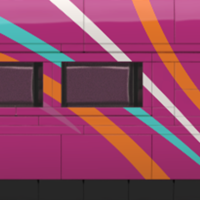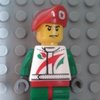-
Content Count
55 -
Joined
-
Last visited
About scruffulous

Spam Prevention
-
What is favorite LEGO theme? (we need this info to prevent spam)
Trains
Contact Methods
-
Website URL
http://
-
ICQ
0
Profile Information
-
Gender
Male
Extra
-
Country
Australia
-

[OcTRAINber MOC] LMS Articulated Railcar (1938)
scruffulous replied to Hod Carrier's topic in LEGO Train Tech
Congratulations on effectively modelling two completely different trains, at a very high level of detail, and with some great technical solutions, and all in a short timeframe. A hard earned and well deserved win! -
I think this is my first time posting in the Town forum. I usually build trains and so post in the Train Tech forum. I hope my model fits here. The image below is of a Fordson E1A Major farm tractor. I wanted to build one of these, not because I needed an agricultural tractor, but because they were used by the Victorian Railways (VR) in the construction of rail tractors (shunting locos). The VR basically bolted one of these tractors to an old train wagon underframe and connected the tractor's drive train to the wheels of the wagon with a chain to create a rail tractor - a simple, but effective, design. Here's my model, which is scaled at 1:45. The design is heavily influenced by Damian Z’s work (e.g. rear wheel guards using neck brackets and steering wheel mounted on clip). This little tractor is made up of only 74 parts, but it includes some expensive ones, particularly the blue Plate, Round 1 x 1 with Open Stud (AU$8.11 x 2) and the blue Brick, Modified 1 x 2 x 2/3 with Studs on Sides (AU$6.70). I could have substituted the modified brick for a cheaper colour (e.g., black), but I like the continuation of the blue from the hood through to the rear. The blue round plates only appeared in one set (Alien Puppycorn, Unikitty!, Series 1), and it was much cheaper to buy the set (~AU$3.50) and get two blue round plates (one standard part, plus one extra), than it was to buy them separately.
-

[MOC] M Class diesel hydraulic locomotive
scruffulous replied to scruffulous's topic in LEGO Train Tech
I'm not sure what you mean about the corner tiles - do you mean the slopes without a stud on the roof of the cab? -
Thanks all. Using the antistuds of a plate for the underframe sides is one of my favourite techniques for adding detail. It's not quite scale height for most underframes (two plates would be closer), but the sides of plates are so boring ;-) They are supposed to represent angled axle boxes - not all I wagons had them installed. I think the angle was to make it easier to add lubricant, or possibly to help create a well to hold the lubricant. The yellow stripe differentiated GY wagons, which were grain-proofed, from HY wagons, which were not grain-proofed.
-
Like most railways, the Victorian Railways (VR) built a huge number of four wheel open wagons. The first class were I wagons, and they constructed ~15000 of them, starting in 1859. In the 1950s and 1960s, the steel underframes of I wagons were repurposed as many other classes. Below is my model of a steel underframe I wagon. There is only a small amount of internal structure holding the sides and ends in place, so they can be run as an open wagon. From 1939, the VR started building GY wagons. They built over 6000, so they were a common sight, particularly as long rakes during the wheat harvest. Below are two models of a GY wagon; one painted in normal VR wagon red, and the other in hansa yellow. This is the third version of a GY wagon I've built, and it's the most detailed, the most accurate (1:45 scale-wise), and the best running (thanks to ball bearings). The tarp is clearly not LEGO - it's made from baby wipes. These wagons can't be run without a tarp or load to cover the internal structure that holds the sides and ends in place.
-
Here is my model of a Victorian Railways M Class locomotive (M231). Only two of the prototype were ever built, and they spent most of their lives as shunting locos at the Newport workshops. This model recently won the Best Diesel Locomotive Model for the Asia and Australasia region in the Brick Train Awards 2022. I started building this for OcTRAINber 2021 (Critters), but didn't complete it in time. In a change from my normally purist approach, I've used a number of 3D printed parts: the wheels, cranks, connecting rods, handrails and side rod protection connectors are all 3D printed. The wheels, cranks and connecting rods needed to be thin so I could fit them behind side rod protection. I tried a new approach to printing the cranks and connecting rods - they were printed in place (i.e., they were printed as a single part with small supports that need to be broken to get the crank pins moving within the connecting rod). It worked really well, with only a ~20% failure rate. You can see them in action here. You might wonder why I bothered with accurate running gear, given it's usually covered by the side rod protection. The main reason is it dramatically improves performance, given only the front wheels are powered. The M Class is supposed to have an external frame (i.e., the wheels hidden behind the frame), so I'm considering 3D printing a thin frame for between the wheels and the cranks. I probably at least need to cover the Bluetooth Battery Cube with black vinyl. Here's the other M Class loco (M232) in a different livery.
-
Thanks all. I didn’t have enough time to take heaps of photos. Will try to get some more (including the train) over the next few days.
-
This is my entry for OcTRAINber 2020: Dioramas, Dioramas Everywhere. It fits in the “Huge” category (6+ 32x32 baseplates) - it's 45 32x32 baseplates! OcTRAINber 2020: The 17th Hole by Mike Pianta, on Flickr OcTRAINber 2020: The 17th Hole by Mike Pianta, on Flickr It represents part of a golf course, highlighting the 17th Hole, a short Par 3. At the scale I build (1:45), the hole plays just 118 yards (108 m), but bunkers and rough surround the small green, leaving little room for players to miss safely. There is also a green for the Par 5 16th Hole and a track leading to the tee for the Par 4 18th Hole. It's based on an idea from Jim Spavin's book "Modular Railroading Handbook - Second Edition".
-
Would it look better with the wheels flipped to the other side so the "flange" is smaller?
-

[MOC] Totternhoe: Narrow Gauge Railway
scruffulous replied to scruffulous's topic in LEGO Train Tech
So, I've been called nuts over on Flickr and insane here on Eurobricks - are you guys trying to tell me something ;-) The kids at the show loved it when there was a "spooky" gap between the rolling stock. -

[MOC] Totternhoe: Narrow Gauge Railway
scruffulous replied to scruffulous's topic in LEGO Train Tech
Thanks. I'd booked this layout idea into Brickvention way ahead of OcTRAINber, but it took me a long time to realise that I could use a test-build as an entry for that competition. Actually, I'm not sure I would have been able to present a working layout if I hadn't done that - OcTRAINber allowed me to iron out some of the technical issues. Puffing Billy was integrated into the VRLGM Victorian Railways layout, which was appropriate. This layout, which is based on narrow gauge railways in the heart of England, would be out of place there, so will most likely stay as stand-alone (but will hopefully improve in quality and size). Thanks. I feel the same way about the gauge. I really struggled to get the dimensions right for the tilt skips. The ones I built for OcTRAINber were all wrong, but I think they're pretty close now. -

[MOC] Totternhoe: Narrow Gauge Railway
scruffulous replied to scruffulous's topic in LEGO Train Tech
Can't upload the LDraw file here, but there aren't that many parts, so you should be able to figure it out from this exploded image. Tilt Skip Exploded by Mike Pianta, on Flickr -

[MOC] Totternhoe: Narrow Gauge Railway
scruffulous replied to scruffulous's topic in LEGO Train Tech
Thanks all. I actually deliberately haven't coupled the wagons together - one advantage of not coupling them is that I can decouple the hidden carriers below without my hand interrupting the view from above. It's not as straight forward as using stronger magnets. I'm already using pretty strong ones, and if I go stronger the attraction/repulsion between magnets on the carriers causes the carriers to tip over (even when weighted). Yeah, if the loco/wagon is too heavy, or the track is too uneven, the carriers (below) separate from their rolling stock (above). A thinner base does help (my OcTRAINber prototype, which was straight track, had a thinner base), but I need the current thickness to build the points and other tricky track geometry. I'm hoping to get my steamer running soon. I've got the tilt skips in LDraw - would that be useful? -
This is the narrow gauge train layout I presented at Brickvention 2019, based on the idea I developed for OcTRAINber 2018 (i.e. using a hidden subsystem of L-gauge train "carriers" connected to the visible narrow gauge trains above via magnets). Totternhoe - Brickvention 2019 by Mike Pianta, on Flickr You can see it in action in this video: Totternhoe by Mike Pianta, on Flickr While the layout worked well enough to give me encouragement to continue to refine it, there were a number of issues that meant, at first, I couldn't reliably run most of my locos. The green simplex is a loco with the cab removed to reduce weight. This was the most reliable loco I had because it was light. I had to rebuild the yellow diesel to reduce the weight, and it ended up being fairly reliable. I did get the base (i.e. no cab) of a steam loco (not shown) round the loop, but ran out of time at the convention to fully test it with the cab. I think I can get it there, though. So, lots of issues, and dealing with them meant that I didn't have time to detail the layout as much as I would have liked - I think it looks a bit plain. I'm hooked, though - I love the challenge, and the cuteness of the narrow gauge trains is irresistible.
-

[MOC] Motorised tiny narrow gauge trains
scruffulous replied to scruffulous's topic in LEGO Train Tech
Thanks. There are no secrets. I'm not the first to do this type of thing (although perhaps the first to do it with trains). Happy to share; hope others find it useful. The lower magnets run very close to the smooth bottom of the baseplate (they actually brush it in places where the baseplate sags a bit). The upper and lower magnets are separated by about 6 plates, with the baseplate and track ballast in between. The magnetic attraction is strong enough to fairly reliably keep them connected across that gap. The height of the lower system is for a few reasons: it allows for the PF components, it matches the height of the standard LEGO supports (so it's convenient), and there's enough room to reach my arm under if there is a problem. I used PF primarily to get better speed control. I don't see any issues using 9V, although you might run into issue if you mount the magnets too close to the 9V motor. You can run them pretty fast. Speed actually helps overcome some issues with uneven track - the momentum of the rolling stock helps ride over bumps. In general, though, uneven track is a problem. I use custom tables that can be accurately leveled to minimize this. Reducing the separation between the magnets can help, although it can also make things worse - reducing the separation increases the magnetic force, which effectively makes the rolling stock "heavier", which can make uneven track worse. Hope that helps. If you are interested in more detail, I've given a fairly complete account of the development of the system in this discussion on Flickr (search for the scruffulous entries): https://www.flickr.com/groups/3699484@N23/discuss/72157674019840858/- 10 replies
-
- train
- narrow gauge
-
(and 4 more)
Tagged with:





